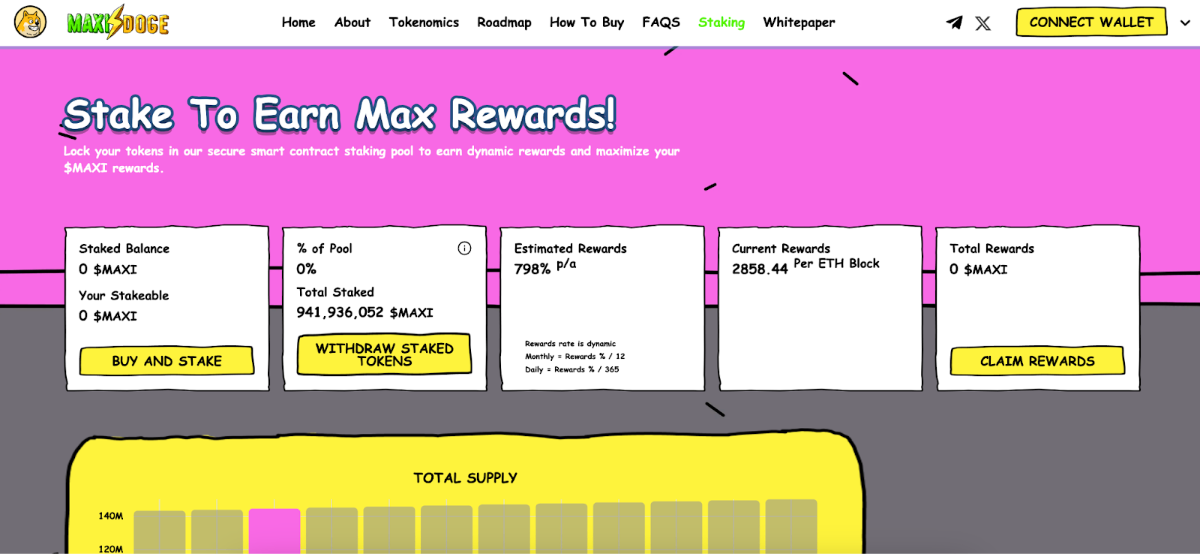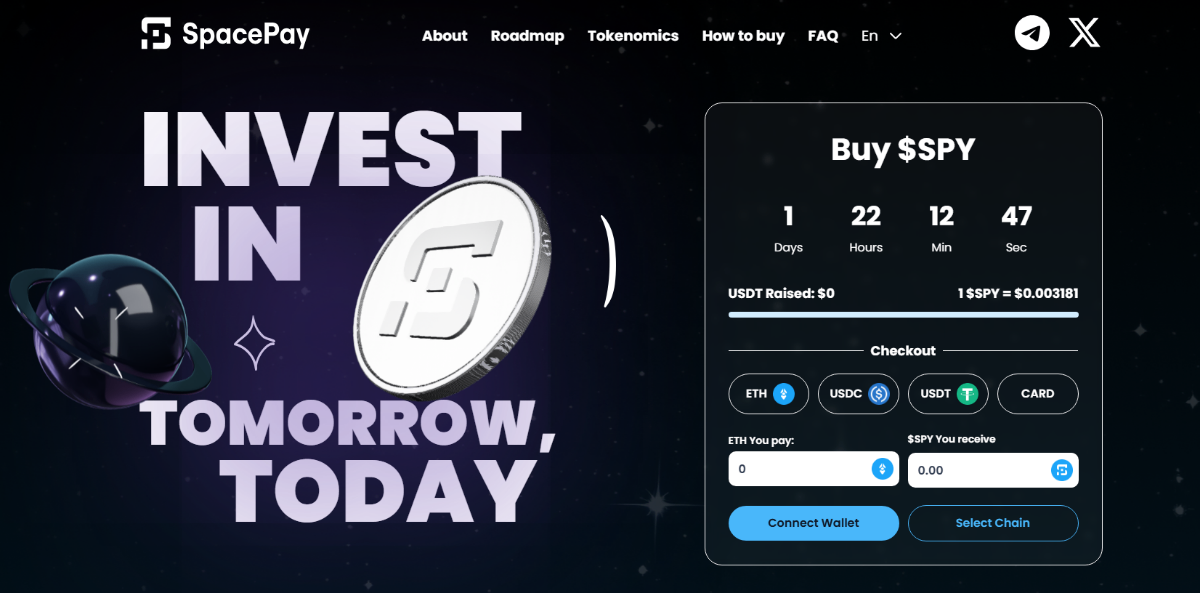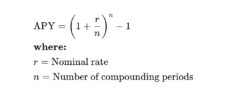With a good audit score and a structured presale, MoonBull (MOBU) looks promising. Still, anonymous leadership and aggressive mark...
Best Crypto to Stake in 2025: Top Staking Coins for Passive Income
 30 mins
30 mins We analyzed hundreds of staking projects to find out which ones are the best options for passive income in 2025, and according to our research, the project with the best staking APYs and terms is Bitcoin Hyper.
Bitcoin Hyper provides a 43% APY as the first Bitcoin Layer 2 solution. Other good options include Maxi Doge and Polkadot. Maxi Doge is marketing staking profits of up to 77% to degen trader bros, while Polkadot has a more stable and secure historical 16.8% APY.
Our methodology and analysis reveal that the highest-performing staking opportunities in 2025 balance attractive yields with project sustainability, technological innovation, and growing user adoption.
Best Crypto to Stake Key Takeaways
- Bitcoin Hyper leads with 43% as the first Bitcoin Layer 2 network, raising $27.86M in presale while unlocking DeFi for the $1.5 trillion Bitcoin ecosystem.
- Maxi Doge delivers tiered staking APYs with a fixed supply of 150 billion tokens, and a growth‑oriented tokenomics model with 25% in the MAXI Fund and 40% dedicated to marketing.
- Established networks like Polkadot deliver 16.8% APY with proven stability, while Avalanche offers 6.7% APY with zero slashing risk for conservative investors.
Best Crypto Staking Coins to Watch in November 2025 – Top Picks
We carefully curated a selection of this month’s most promising staking opportunities, combining high reward potential with solid project fundamentals. Here is the list.

- First Bitcoin Layer 2 enabling fast, low-cost transactions
- Fixes Bitcoin’s speed and fee limitations with near real-time performance
- Enables a Bitcoin-native DeFi ecosystem

- Degen meme coin inspired by max-leverage trading
- A tribute to high-risk hustle — fueled by sweat and conviction
- Ethereum-born, culture-driven, aiming for multichain

- Build your own virtual meme coin mining rig.
- 100% virtual and requires no additional computing power.
- Top miners get additional bonuses in Pepe, Fartcoin, and other meme coins.

- Exclusive in-app access to vetted crypto presales
- Staking rewards with an annual percentage yield (APY) of up to 152%
- Upcoming Best Card enables crypto spending at millions of merchants with cashback

- AI-Powered Virtual Influencers
- 20% APY Staking Rewards
- VIP perks: livestreams, BTS content, credits, and more.
Best Coins for Staking in 2025
- Bitcoin Hyper (HYPER) – Bitcoin Layer 2 rollup offering 43% staking rewards
- Maxi Doge (MAXI) – Dogecoin spinoff with dynamic staking rewards up to 77% for community members
- Polkadot – Blockchain interoperability protocol offering 16.8% historical rewards rate
- PEPENODE (PEPENODE) – Build virtual mining rigs with up to 611% staking rewards.
- Avalanche (AVAX) – High-performance blockchain with 6.7% APY and no slashing risk
- Best Wallet Token (BEST) – Next-gen wallet with 77% presale staking APY
- SUBBD (SUBBD) – AI-driven content platform with 20% fixed APY
- SpacePay (SPY) – Crypto payment platform built to accommodate everyday merchants
- Algorand (ALGO) – Pure Proof-of-Stake blockchain with 5.70% APY and no lock-up periods
- Little Pepe (LILPEPE) – Building a new Layer 2 network from the ground up for meme coins
- BlockchainFX (BFX) – All-in-one crypto and traditional asset trading platform
- Polygon (POL) – Ethereum’s leading scaling solution with 4.95% staking APY and near-zero transaction fees
Best Crypto to Stake – Analysis and Reviews
Here’s our detailed analysis of each staking opportunity, covering everything from APY potential to lock-up requirements and platform security.
1. Bitcoin Hyper – First Bitcoin Layer 2 Network
Bitcoin is huge, but it has one major flaw that nobody talks about – it can’t really run smart contracts. And that’s what Bitcoin Hyper wants to improve.
Bitcoin Hyper is the first Layer 2 network built on the Solana Virtual Machine (SVM). The project unlocks DeFi capabilities for Bitcoin holders by combining Bitcoin’s security with Solana’s transaction speed and low fees, potentially activating the $1.5 trillion Bitcoin ecosystem for smart contracts and decentralized applications.

Bitcoin Hyper presale website. Source: Bitcoin Hyper
- Why It’s Good for Staking: Currently offering 43% with sustainable tokenomics backed by transaction fee revenue, over 109 million.
- Suitable For: Bitcoin maximalists seeking DeFi exposure, Layer 2 technology believers, and high-yield staking enthusiasts wanting Bitcoin ecosystem participation.
- Staking Options: Immediate presale staking with a decreasing APY model that rewards early participants while maintaining long-term sustainability.
- Community Growth: Almost 15,000 Telegram and X followers, with growing engagement from the Bitcoin community.
- Lock-Up Period: Tiered system with early withdrawal penalties to ensure network stability.
| Category | Bitcoin Layer 2 |
| Chain | Bitcoin/SVM Hybrid |
| Staking APY | 43% |
| Lock-up | Tiered System |
| Platform | Presale, Bitcoin L2 |
| Amount Raised | $27.86M |
| Community | Almost 15K on Telegram and X |
2. Maxi Doge – Dogecoin Spinoff with Massive Staking Rewards for Community Members
Next one on our list of best staking crypto right now is Maxi Doge, a new meme coin that targets the $53B dog-themed market, and harnesses the language, symbols, and mindset of degen shitcoin traders. While it isn’t focused on utility, Maxi Doge does offer staking with up to 77%, and it’s planning contests to reward its community with more $MAXI tokens.

Maxi Doge staking rewards. Source: Maxi Doge
The project’s mascot is a buff Shiba Inu who trades meme coins at 1000x leverage 24/7 while chugging Red Bull. Maxi Doge isn’t building some massive ecosystem of DeFi apps or P2E games. It’s just a shitcoin with great memes, a fun mascot who flips shitcoins with 1000x leverage, and an exponentially growing community of meme coin enthusiasts.
- Why It’s Good for Staking: Currently offering 77% with nearly 1 million $MAXI staked.
- Suitable For: Meme coin traders, degen leverage traders, Dogecoin holders, staking aficionados, and small cap coin investors.
- Staking Options: Live $MAXI staking with up to 77%.
- Community Growth: Incredibly fast growth on both social media and the presale.
- Lock-Up Period: Flexible staking terms with early withdrawal options.
| Category | Meme |
| Chain | Ethereum |
| Staking APY | Up to 771% |
| Lock-up | Flexible, with early withdrawal options |
| Platform | Presale |
| Market Cap | $37.6M |
| Community | Over 7,300 followers on X with active engagement growth |
3. Polkadot – Future of Blockchain Interoperability
Polkadot operates as a Layer 0 protocol designed to connect and secure multiple blockchains, enabling smooth interoperability between private and public networks, oracle services, and various protocols. The platform’s Nominated Proof-of-Stake (NPoS) consensus mechanism allows token holders to participate in network security while earning competitive staking rewards.

Polkadot staking dashboard. Source: Polkadot
- Why It’s Good for Staking: Currently offering a 16.8% historical rewards rate with 54% of the DOT supply actively staked by 31,276 nominators. The NPoS system distributes rewards equally among validators regardless of stake size.
- Suitable For: Blockchain interoperability believers, long-term crypto investors seeking stable returns, and users wanting exposure to the multi-chain ecosystem.
- Staking Options: Direct nomination with 1 DOT minimum through pools, validator operation with 250+ DOT, or hardware wallet integration through Ledger with 254 DOT minimum requirement.
- Community Growth: 600 active validators securing the network with over 31,000 nominators participating.
- Lock-Up Period: A 28-day unbonding period for direct staking, providing security against long-range attacks while maintaining network stability.
| Category | Interoperability Protocol |
| Chain | Polkadot |
| Staking APY | 16.8% |
| Lock-up | 28 Days |
| Platform | Native Dashboard |
| Market Cap | $5.3B |
| Community | 1.5M followers on X, and 23K on Telegram |
4. PEPENODE – Ethereum Meme Coin That Lets You Build Virtual Mining Rigs
PEPENODE is a new meme coin that combines the usual frog memes with a simple mining game where you can earn tokens. Instead of just holding your coins and hoping they go up, you can stake them and build virtual mining setups to earn more.
The concept is pretty straightforward. You buy PEPENODE tokens, stake them in the system, and then build out digital mining rigs. The better you set up your virtual equipment, the more tokens you earn.

PepeNode presale dashboard. Photo: PEPENODE
- Why It’s Good for Staking: Revolutionary mine-to-earn system that offers 611% with real-time Ethereum block synchronization.
- Suitable For: ETH-native users, DeFi gamers, meme coin enthusiasts, high-risk miners, and virtual gaming fans.
- Staking Options: Live mine-to-earn protocol with virtual rig customization and dynamic rewards.
- Community Growth: Early momentum building among DeFi gamers and meme coin enthusiasts who appreciate projects with tangible utility.
- Lock-Up Period: Rewards distributed over 2 years with flexible withdrawal options available.
| Category | Meme Coin + Gaming |
| Chain | Ethereum |
| Staking APY | 611% |
| Lock-up | 2-year reward distribution |
| Platform | Presale |
| Amount Raised | $2.16M |
| Community | 2,2K followers on X, and 2K+ on Telegram |
5. Avalanche – High-Performance Blockchain Validator
Avalanche is a blockchain platform built for scale, with transactions that finalize in under a second through its consensus mechanism. Developers can launch their own Layer 1 chains that connect to the main network, validators don’t need expensive hardware, and the system doesn’t penalize nodes for typical errors.

Avalanche staking metrics. Source: Avalanche
- Why It’s Good for Staking: Currently offering 6.7% APY with no slashing risk, making it one of the safest staking environments available. With 231.7 million AVAX staked across 1,483 validators and a 50.20% staking ratio.
- Suitable For: Risk-averse investors seeking steady returns without slashing penalties, developers building scalable applications, and validators wanting low hardware requirements.
- Staking Options: Direct validator operation with 2,000 AVAX minimum, delegation to existing validators with no minimum requirement, or third-party platforms offering flexible terms and instant liquidity.
- Community Growth: 1,483 active validators with 53,027 total delegations.
- Lock-Up Period: Flexible unbonding periods depending on staking method, with some platforms offering instant liquidity while maintaining reward eligibility.
| Category | High-Performance Blockchain |
| Chain | Avalanche |
| Staking APY | 6.7% |
| Lock-up | Flexible |
| Platform | Native Wallet |
| Market Cap | $7.3B |
| Community | 1.1M followers on X, 32K+ on Telegram |
6. Best Wallet Token – Next-Generation Crypto Wallet
Best Wallet Token powers a crypto wallet ecosystem that combines secure non-custodial functionality with an integrated DEX and “Upcoming Tokens” launchpad for presale discovery. The platform has processed over $16.85M in presale investments while maintaining a 4.5-star rating across app stores and securing 500,000+ downloads.

The Best Wallet Presale website. Source: Best Wallet
- Why It’s Good for Staking: Currently offering 77% APY for presale participants with $16.85M raised, token holders receive 30% transaction fee reductions and priority presale access.
- Suitable For: Security-conscious investors, presale hunters seeking early access, multi-chain users, and passive income seekers through staking aggregation.
- Staking Options: Presale staking with 8% of the total supply allocated for rewards and 10% for exchange liquidity to ensure sustainable growth.
- Community Growth: 500,000+ app downloads with almost 79,000 X followers and 50,000 Telegram members.
- Lock-Up Period: Flexible staking terms with early withdrawal options for active wallet users.
| Category | Wallet Infrastructure |
| Chain | Multi-chain Support |
| Staking APY | 77% |
| Lock-up | Flexible |
| Platform | Best Wallet App |
| Amount Raised | $16.85M |
| Community | 79,000 X followers and 50,000 Telegram members |
7. SUBBD – AI-Powered Content Creation Platform
SUBBD works with 2,000 influencers who have 250 million combined followers in what Forbes calls an $85 billion market.
The platform uses blockchain for payments and provides AI tools – influencer avatars, voice synthesis, and video creation. Creators keep more money since they bypass the 50% cuts that YouTube and TikTok take.

SUBBD presale. Source: SUBBD
- Why It’s Good for Staking: Fixed 20% APY with $1.35M raised. The platform already serves 2,000+ active influencers with proven market demand, offering immediate real-world utility beyond speculation.
- Suitable For: Content creators, AI technology investors, Web3 enthusiasts seeking utility-driven projects, and investors wanting exposure to the intersection of AI and creator monetization.
- Staking Options: Presale staking with a 7-day withdrawal period after token launch, plus VIP content access and platform benefits for stakers during the holding period.
- Community Growth: 2,000+ verified influencers actively promoting with 250 million combined follower reach, 78,000 X followers, and 19,000 Telegram members.
- Lock-Up Period: Seven days post-launch with immediate access to platform benefits during the staking period.
| Category | AI Content Creation |
| Chain | Multi-chain Support |
| Staking APY | 20% |
| Lock-up | 7 Days Post-Launch |
| Platform | SUBBD App |
| Amount Raised | $1.35M |
| Community | 250M Platform Followers, 78,000 X, and 19,000 Telegram followers |
8. SpacePay (SPY) – The Crypto Payment Platform Built for Everyday Merchants
SpacePay is a London-based payment platform that lets merchants accept crypto through their existing Android POS terminals without buying new hardware or learning complex systems. The platform supports over 325 crypto wallets and instantly converts crypto payments to local fiat currency, so merchants never worry about price swings wiping out their profits.

Caption: SpacePay page displaying how much the presale raised and current token price. Source: SpacePay
With a 0.5% transaction fee compared to the 2-3% that traditional card processors charge, merchants can save hundreds or thousands of dollars using SpacePay.
- Why It’s Good for Staking: SPY holders share in platform revenue through a revenue-sharing model where token holders earn a portion of transaction fees, creating passive income that grows as more merchants join and process more payments through the network.
- Suitable For: Active crypto users who want to spend their digital assets in everyday commerce, merchants tired of high credit card fees, and investors who want exposure to real payment utility rather than pure speculation.
- Trading Features: SPY holders get voting rights on platform updates and feature development, monthly loyalty airdrops for active participation, early access to new features before public release, and the ability to influence how the platform grows through governance.
- Community Growth: Over 20,000 beta testers have already tried the platform, and the presale has attracted over $1 million from early supporters who see the potential in bridging crypto and traditional commerce.
| Category | Multi-Asset Payment Platform |
| Chain | Multi-chain |
| Presale Price | $0.00421 |
| Transaction Fee | 0.5% |
| Supported Wallets | 325+ |
| Presale Raised | $1M+ |
| Community | 20,000+ beta testers |
9. Algorand – Pure Proof-of-Stake Innovation
Algorand is an energy-efficient, quantum-secure blockchain with instant finality, consistently high throughput of 10,000 TPS, and low fees. The platform’s Pure Proof-of-Stake (PPoS) consensus mechanism enables participation without traditional validator requirements, while offering real-time rewards distributed every 2.8 seconds as blocks finalize.

Algorand staking dashboard. Source: Algorand
- Why It’s Good for Staking: Currently offering 5.70% APY with no slashing risk and no lock-up periods, making it one of the most accessible staking environments. With 3,717 mainnet nodes and 1.88 billion ALGO staked online.
- Suitable For: Security-conscious investors seeking slashing-free rewards, users wanting instant liquidity without lock-up periods, and participants interested in network governance through direct voting rights.
- Staking Options: Solo staking with a 30,000 ALGO minimum for direct participation, liquid staking through ecosystem applications for smaller holdings.
- Community Growth: 1,927 online accounts with 1,607 accounts above 30K ALGO threshold.
- Lock-Up Period: No lock-up required – staked tokens remain in user wallets while participating in consensus, providing maximum flexibility and instant liquidity.
| Category | Pure Proof-of-Stake |
| Chain | Algorand |
| Staking APY | 5.70% |
| Lock-up | None |
| Platform | Native Wallets |
| Market Cap | $1.5B |
| Community | 230K+ followers on X and Telegram |
10. Little Pepe – Creating a New Meme Coin Layer 2 Hub
Little Pepe is a new meme coin with an extraordinarily ambitious goal: to power a new home for the meme coin ecosystem. Slow transactions and hefty gas fees have hampered the meme token market for years. The Little Pepe team believes that it has the solution: a fast and cheap Layer 2 network built for meme coins. Clearly, investors see a ton of potential in the project because it has already raised over $27 million in the presale for its utility token, $LILPEPE.

Little Pepe presale homepage. Source: Little Pepe
- Why It’s Good for Staking: The team has allocated 13.5% of its total supply for staking rewards. Similar presale tokens often offer massive rewards, especially early on, so keep an eye out when it launches after the TGE.
- Suitable For: Meme coin aficionados, investors looking for high staking rewards, and speculators with a high tolerance for risk.
- Staking Options: LILPEPE staking should launch soon after the TGE, likely offering substantial rewards.
- Community Growth: Over 38,000 community members in its Telegram channel.
- Lock-Up Period: TBA.
| Category | Meme coin Layer 2 |
| Chain | Ethereum |
| Staking APY | Variable |
| Lock-up | TBA |
| Platform | Native Dashboard |
| Market Cap | Still in presale |
| Community | 38K on Telegram |
11. BlockchainFX – All-in-One Crypto and Traditional Asset Trading Platform
BlockchainFX is the first crypto-native platform where users can trade over 500 assets including crypto, forex, stocks, ETFs, futures, options, and bonds without switching between multiple brokerages or platforms. The presale has already raised $10.88 million from 16,936 participants at $0.029 per token, with the launch price set at $0.05.
- Why It’s Good for Staking: BFX holders earn daily rewards in both BFX and USDT from up to 70% of all trading fees the platform makes, which creates a steady passive income that grows as more people trade on the platform.
- Suitable For: Active traders who want access to multiple asset classes, crypto investors who want passive income from trading fees, and anyone tired of managing accounts across different exchanges and brokerages.
- Trading Features: Swap between crypto, forex, commodities, stocks, and ETFs instantly on one platform with leverage trading, advanced risk management tools, and zero need to switch accounts for different markets.
- Community Growth: Over 20,000 beta testers gave the platform a 4.79 out of 5 rating, with 72% who said they would use BlockchainFX exclusively and 86% who plan to use it regularly after launch.
| Category | Multi-Asset Trading Platform |
| Chain | Multi-chain |
| Presale Price | $0.029 |
| Launch Price | $0.05 |
| Revenue Share | Up to 70% of trading fees |
| Presale Raised | $10.88M+ |
| Community | 16,936+ presale participants |
12. Polygon – Ethereum’s Leading Scaling Solution
Polygon runs as an Ethereum sidechain with EVM compatibility and transaction fees around $0.015. The Proof-of-Stake network has processed 2.44 billion transactions, hosts contracts from 28,000 developers, and serves 219 million unique addresses.

Polygon staking dashboard. Source: Polygon
- Why It’s Good for Staking: Currently securing 3.7 billion POL across 103 total validators with over 1.1 billion POL already distributed in rewards, the network maintains a 95% performance benchmark with consistent 29-minute checkpoint intervals.
- Suitable For: Ethereum users seeking lower transaction costs, DeFi participants wanting fast settlement times, and validators interested in securing the most adopted Layer 2 scaling solution.
- Staking Options: Delegate POL to validators through the native staking dashboard, participate in validator operations, or use third-party platforms offering liquid staking solutions.
- Community Growth: Massive ecosystem with 219+ million unique addresses, 1.17+ million deployed smart contracts, and $12.80+ billion in NFT sales.
- Lock-Up Period: Standard delegation unbonding periods with checkpoint-based reward distribution every 29 minutes for consistent yield generation.
| Category | Ethereum Scaling |
| Chain | Polygon PoS |
| Staking APY | Variable |
| Lock-up | Standard Terms |
| Platform | Native Dashboard |
| Market Cap | $10.2B |
| Community | 2M followers on X, 53K on Telegram |
What Is Crypto Staking?
Crypto staking involves locking up cryptocurrency holdings to support the operations and security of a blockchain network in exchange for rewards. In essence, staking involves locking up a certain amount of cryptocurrency in a wallet to support blockchain operations, similar to earning interest in a traditional savings account, except staking involves active participation in network validation or governance activities.
In other words, crypto staking is like putting your money in a high-yield savings account, but instead of a bank paying you interest, a blockchain network pays you rewards for helping keep it running smoothly.
Staking cryptocurrency is a hands-on approach to generating passive income. When you stake tokens, you essentially become a validator (or supporting validators) who verify transactions and maintain network consensus. In return for this service, the network distributes newly minted tokens or transaction fees as rewards.
The process works through Proof-of-Stake (PoS) consensus mechanisms, where validators are chosen to create new blocks based on their stake size and other factors like randomization. Unlike Proof-of-Work mining, which requires expensive hardware and energy consumption, staking only requires holding the native cryptocurrency. This makes staking more environmentally friendly and accessible to regular investors.
Crypto Staking Rewards Explained
Crypto staking rewards are usually calculated in terms of APY (annual percentage yield), which is the interest earned over one year based on the amount of cryptocurrency staked. The APY varies significantly across different projects, depending on factors like network demand, total staking supply, and underlying tokenomics. Here is how APY is calculated:

APY Formula. Source: Investopedia
Rewards typically come from two primary sources: newly minted tokens created through inflation and transaction fees collected from network users. Some networks use a fixed inflation schedule, while others adjust rewards based on total staking participation. When fewer tokens are staked, individual rewards increase to promote more participation, and vice versa.
Staking in Proof-of-Stake (PoS) networks generates rewards primarily from transaction fees. Some projects offer rewards from a dedicated reward pool integrated into the network’s tokenomics. The distribution frequency varies by network, with some paying daily, weekly, or per epoch (a specific time period in blockchain operations).
Understanding real vs. nominal yields is crucial for staking success. While a project might advertise 100% APY, high inflation rates could mean the token’s purchasing power decreases faster than rewards accumulate. Our analysis always considers inflation-adjusted returns to provide accurate profitability assessments.
Staking Crypto Presale and Launch Timelines
Understanding project timelines helps you plan your staking strategy and maximize rewards during different phases. Presale projects offer higher APYs during their initial coin offering phase but carry greater risk, while established networks provide proven stability with immediate liquidity.
| Token | Launch Date | Presale Status | APY | Type |
| Bitcoin Hyper | May 2025 | Active | 77% | Presale |
| Maxi Doge | July 2025 | Active | 77% | Presale |
| Polkadot | Live | Already Launched | 16.8% | Established |
| PEPENODE | July 2025 | Active | 611% | Presale |
| Avalanche | Live | Already Launched | 6.7% | Established |
| Snorter Bot | May 2025 | Ongoing | 109% | Presale |
| Best Wallet | November 2024 | Active | 77% | Presale |
| SUBBD | April 2025 | Presale Phase | 20% | Presale |
| Algorand | Live | Already Launched | 5.70% | Established |
| Little Pepe | TBA | Active | TBA | Presale |
| Polygon | Live | Already Launched | 4.95% | Established |
How We Picked These Crypto Staking Projects – Our Methodology
Our selection process for the best crypto staking opportunities combines quantitative analysis with qualitative assessment across multiple critical dimensions. We evaluated over 100 staking projects using a scoring system based on Coinspeaker’s own methodology that balances recent performance with future perspectives.
Staking APY Analysis (20%)
We assessed annual percentage yields across different platforms and staking methods, adjusting for inflation rates and reward sustainability. Projects offering extremely high APYs underwent additional scrutiny to verify tokenomics and reward mechanisms.
Our analysis considered both current rates and historical consistency to identify projects with stable reward generation, ranging from presale opportunities with triple-digit returns to established networks with proven track records.
Platform Quality and Security (20%)
We evaluated the staking platform’s technical infrastructure, security audits, and operational track records. This includes assessment of smart contract audits, validator performance metrics, slashing risk management, and platform uptime statistics.
Projects with institutional-grade security measures and transparent operations received higher scores, whether they’re emerging presale projects or established networks like Polkadot and Avalanche.
Project Fundamentals and Utility (20%)
We analyzed the underlying technology, use cases, development activity, and market positioning of each project. This evaluation includes examining whitepapers, development roadmaps, partnership announcements, and real-world adoption metrics.
Projects with clear utility beyond speculation and active development communities scored higher, from Telegram trading automation to Bitcoin Layer 2 scaling solutions.
Lock-up Terms and Flexibility (20%)
We assessed the accessibility and flexibility of staking terms, including minimum requirements, withdrawal periods, and penalty structures. Projects offering multiple staking options, reasonable minimums, and flexible terms received preference, as these factors significantly impact investor experience and capital efficiency. This ranges from no lock-up periods on Algorand to presale staking with early withdrawal options.
Community and Ecosystem Strength (20%)
We evaluated community engagement metrics, social media presence, developer activity, and ecosystem partnerships. Strong communities often indicate project longevity and provide early warning signs of potential issues.
Projects with active, engaged communities and growing ecosystems received additional consideration in our final rankings, whether through verified influencer networks or validator participation.
Why 2025 Is Big for Crypto Staking
Crypto staking has entered a new phase of maturity and mainstream adoption in 2025, driven by several factors that make this year good for passive income strategies. According to Reuters, the US Treasury Secretary’s projection of stablecoin growth is expected to be $2 trillion by 2028. These numbers, combined with clearer regulatory frameworks emerging globally, have created an environment where both institutional and retail investors feel confident entering staking markets.
The institutional adoption wave continues accelerating, with major corporations adding staking assets to their treasury portfolios. Corporations like GameStop and MicroStrategy have added more than $1.75 billion in Bitcoin exposure this year, while traditional financial institutions launch regulated staking products. This institutional validation provides the infrastructure and legitimacy that staking markets needed to mature beyond early adopter phases.
Technology improvements across major networks have also helped the staking experience. Ethereum’s successful transition to Proof-of-Stake and the emergence of liquid staking protocols have eliminated many traditional barriers like high minimum requirements and lock-up periods. Ethereum staking now offers competitive yields ranging from 2.07% to 4.53% APY across various platforms, while maintaining the security and decentralization that institutional investors demand.
Market dynamics in 2025 also favor staking as traditional savings accounts continue offering minimal returns while inflation concerns persist. Staking provides higher returns compared to traditional financial instruments, making it an essential component of modern portfolio diversification strategies. The growing advancement of staking platforms, combined with improved user experiences and security measures, has made staking accessible to mainstream investors who previously found the technical requirements prohibitive.
How Do You Stake Crypto?
Getting started with crypto staking involves a four-step process. The specific requirements vary depending on your chosen cryptocurrency and platform.
Step 1: Choose Your Staking Cryptocurrency
Select a Proof-of-Stake cryptocurrency that aligns with your risk tolerance and return expectations. Consider factors like APY, lock-up requirements, minimum stakes, and project fundamentals.
Step 2: Select Your Staking Platform
You can stake crypto on various platforms, including crypto exchanges, wallet providers, and dedicated staking platforms. Centralized exchanges like Binance and Coinbase offer user-friendly staking with customer support, while decentralized protocols like Lido provide non-custodial options with potentially higher yields.
Step 3: Stake Your Tokens
Transfer your chosen cryptocurrency to your selected platform and follow their staking process. This typically involves selecting a validator (for delegation) or joining a staking pool. Some platforms offer “one-click” staking, while others require more detailed setup depending on your technical preferences.
Step 4: Monitor and Earn Rewards
Once staked, your tokens begin earning rewards according to the network’s distribution schedule. Most platforms provide dashboards to track your staking performance, accumulated rewards, and current APY. You can typically compound your earnings by re-staking rewards automatically.
What Are the Risks of Staking Crypto?
While staking can be a good opportunity for passive income, several risks require careful consideration before committing your funds to any staking protocol or platform. Let’s break the down:
Smart Contract and Technical Risks
Decentralized staking platforms rely on smart contracts that could contain bugs or vulnerabilities. Even audited contracts can have undiscovered flaws that hackers might exploit. Also, validator software bugs or configuration errors could result in slashing penalties, where a portion of your staked tokens gets permanently destroyed.
Market Volatility and Price Risk
Higher yields often come with increased risk, and the crypto market is famously volatile. While you earn staking rewards, the underlying token’s value could decline significantly, potentially resulting in net losses despite positive APY. This risk is particularly pronounced with newer projects offering extremely high yields.
Lock-up and Liquidity Constraints
Many staking arrangements require tokens to remain locked for specific periods, during which you cannot sell or withdraw them. Being bonded with a 28-day unbond or even a 3-day unbond could mean you miss the window to sell during market crashes. This liquidity risk can be costly during volatile market conditions.
Platform and Counterparty Risks
Centralized staking platforms could face regulatory issues, technical problems, or even bankruptcy, which could affect your staked assets. While some platforms offer insurance coverage, protection isn’t universal. Decentralized platforms eliminate counterparty risk but introduce smart contract risks and require more technical knowledge.
Validator Performance and Slashing
If you fail to maintain your node properly, you could lose money. Ethereum has mild penalties for downtime and harsher ones for double-signing, while Polkadot can slash validators for misbehavior or extended downtime. Even when delegating to validators, their poor performance or malicious behavior could affect your rewards.
Regulatory and Tax Implications
Staking payouts are usually taxed as ordinary income on the day they hit your wallet, with that amount becoming the cost basis for any future sale. Changing regulations could impact the legality of staking or its tax treatment, requiring careful record-keeping and potential adjustments to strategy.
Pros & Cons of Staking Crypto Coins Explained
After reading through all the information about crypto staking, let’s compare the advantages and disadvantages below:
Pros of Crypto Staking
- You can earn regular rewards without active trading or technical expertise required
- Support blockchain security and decentralization while earning compensation
- Rewards are reinvested to accelerate portfolio growth through compounding effects
- Higher returns compared to traditional financial instruments like savings accounts or bonds
- Proof-of-Stake consensus is more energy-efficient than Proof-of-Work mining
- Many staking tokens provide voting rights in protocol governance decisions
- Access different risk/return profiles across various blockchain ecosystems
Cons of Crypto Staking
- Funds may be inaccessible for extended periods, limiting financial flexibility
- Rewards can decrease as more participants join staking pools or network conditions change
- Potential permanent loss of staked tokens due to validator misbehavior or technical issues
- Some staking methods require technical knowledge and ongoing maintenance
- Dependence on third-party platforms introduces counterparty and security risks
- Token price declines can offset staking rewards, resulting in net portfolio losses
Final Verdict – Is Staking Crypto Worth It in November 2025?
Based on our analysis, crypto staking presents compelling opportunities for most investors in November 2025, provided they match their strategy to their risk tolerance and investment timeline.
The key to success in 2025 is diversification across different risk categories rather than putting everything into one project. A balanced portfolio might include 70% in established networks for stability and 30% in high-yield presales for growth potential.
Current market conditions strongly favor the adoption of staking. Traditional savings accounts offer practically nothing, while staking provides meaningful returns ranging from 3% to 607% APY. Additionally, liquid staking solutions have addressed the old lock-up issues that previously deterred investors.
With the right strategy and proper diversification, crypto staking has become a crucial tool for building wealth in 2025. Just match your choices to your risk tolerance and investment timeline.
FAQ
What is the best crypto to stake in 2025?
What is the most profitable staking crypto?
Is crypto staking worth it in 2025?
Which crypto gives the highest staking rewards?
Is staking better than just holding crypto?
What is the best crypto wallet for staking?
Which platforms offer the best crypto staking in 2025?
Where can I stake ETH or SOL safely?
What are the tax implications of staking crypto?
References
Coinspeaker in Numbers
Monthly Users
Articles & Guides
Research Hours
Authors
Margin allows traders to speculate on cryptocurrencies with leverage. Our beginner's guide explores the best places to trade digit...
In this guide, we'll analyze PEPETO's fundamentals and forecast where the token could trade over the next five years.
Otar Topuria
Crypto Editor, 19 postsI’m a crypto writer and analyst at Coinspeaker with over three years of experience covering fintech and the rapidly evolving cryptocurrency landscape. My work focuses on market movements, investment trends, and the narratives driving them, helping readers what is happening in the markets and why. In addition to Coinspeaker, my insights and analyses have been featured in other leading crypto and fintech publications, where I’ve built a reputation as a thoughtful and reliable voice in the industry.
My mission is to demystify the crypto markets and help readers navigate the noise, highlighting the stories and trends that truly matter. Before specializing in crypto, I worked in the IT sector, writing technical content on software development, digital innovation, and emerging technologies. That made me something of an expert in breaking down complex systems and explaining them in a clear, accessible way, skills I now find very useful when it comes to unpacking the intricate world of blockchain and digital assets.
I hold a Master’s degree in Comparative Literature, which sharpened my ability to analyze patterns, draw connections across disciplines, and communicate nuanced ideas. I’m particularly passionate about early-stage project discovery and crypto trading, areas where innovation meets opportunity. I enjoy exploring how new protocols, tokens, and DeFi projects aim to disrupt traditional systems, while also evaluating their potential risks and rewards. By combining market analysis with forward-looking research, I strive to provide readers with content that is both informative and actionable.